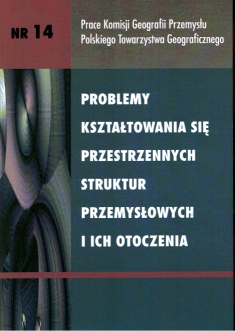Population ageing in industrial areas in Poland
DOI:
https://doi.org/10.24917/20801653.14.12Keywords:
starzenie, przemysł, PolskaAbstract
The aim of the study was to analyse the process of population ageing in selected industrial centres in Poland. Ten industrial towns were taken into account: both old coal-mining areas (Chorzów, Wałbrzych) and industrial areas developed intensively in 1970s and 1980s. In all of them, industrial investments were connected with a high wave of immigration of young people. Nowadays the immigrant population is ageing at a rapid pace, which may have negative consequences for the development of information society. In the years 1988-2007, most of the units recorded a decrease in pre-working population (aged under 18) and an increase in post-working population (aged 60 and over for women and 65 and over for men). According to the demographic transition theory, the proportion of working population (aged 18-59/64) recorded a considerable increase (demographic window of opportunity or demographic bonus), however the changes in the structure of working population were unfavourable with an increase of immobile working population (aged 45-59/64) and a decrease of mobile working population (aged 18-44). According to the author’s own projection up to the year 2030, the negative trends will be confirmed with a considerable drop of the percentage of working population in industrial units, followed by a steady increase in the dependency ratio.Downloads
Metrics
References
Bloom, D.E., Canning D., Sevilla J., 2003, The Demographic Dividend: A New Perspective on the Economic Consequences of Population Change, Population Matters Monograph MR-1274, RAND, Santa Monica.
Długosz Z., 1997, Stan i dynamika starzenia się ludności Polski, „Czasopismo Geograficzne”, 68, 2, s. 227–232.
Długosz Z., 1998, Próba określenia zmian starości demograficznej Polski w ujęciu przestrzennym, „Wiadomości Statystyczne”, nr 3, s. 15–25.
Frąckiewicz L. red., 2002, Polska a Europa. Procesy demograficzne u progu XXI wieku. Proces starzenia się ludności i jego społeczne konsekwencje. I Kongres Demograficzny, Polskie Towarzystwo Polityki Społecznej, Katowice.
Frątczak E., 2002, Proces starzenia się ludności Polski, „Studia Demograficzne”, 2, 142, s. 3–28.
Kotowska I., 1990, Starzenie się zasobów pracy w Polsce, „Studia Demograficzne”, 3 (101), s. 41–61.
Kotowska I., 1992, Demographic determinants of labour force in Poland in 1990–2000, „Polish Population Review”, Polish Demographic Society, Central Statistical Office, Warsaw, 2, s. 41–61.
Kotowska I., 1999, Przemiany demograficzne w Polsce w latach 90. w świetle koncepcji drugiego przejścia demograficznego, Monografie i Opracowania, 461, Szkoła Główna Handlowa w Warszawie.
Kurek S., 2004, The population ageing process against vital statistical changes in Polish towns, „Bulletin of Geography”, No 3, s. 83–96.
Kurek S., 2005, Territorial Distribution of population change in Poland in the years 1991–2001, „Bulletin of Geography”, No 4, Socio-Economic Series, Nicolaus Copernicus University, Toruń, s. 117–134.
Kurek S., 2008, Typologia starzenia się ludności Polski w ujęciu przestrzennym, Wydawnictwo Naukowe AP, Kraków.
Riley M.W., Hess B.B., Bond K., 1983, Aging in Society: Selected reviews and recent research, Lawrence Erlbaum Associates, Publishers, Hills Dale, New Jersey, London.
United Nations, 2005, The Diversity Of Changing Population Age Structures In The World, Population Division, Department of Economic and Social Affairs, http,//www.un.org/esa/population/meetings/EGMPopAge/1_UNPD_Trendpdf.
Downloads
Published
How to Cite
Issue
Section
License
Articles are published under the terms of the Creative Commons License (CC BY-ND 4.0; Attribution– NoDerivs).

